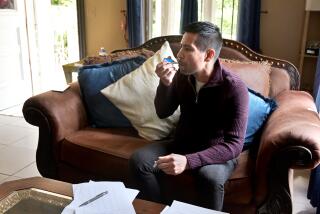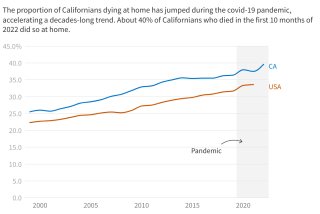More Medical Care Administered With All the Comforts of Home
- Share via
Walter Cochran says hyperalimentation at home is great. His wife, Jennie, agrees.
The 78-year-old Cochran receives the high-calorie, high-nutrition intravenous feeding each night through a tube running from a sophisticated monitoring machine directly into his heart. His wife has been trained to operate the machine, affixing the special bag with its life-saving liquid nutrition formula and determining how fast the fluid drips into her husband overnight.
After the nightly feeding, Cochran--who has been in and out of the hospital for more than 10 years for a variety of ailments--is free to move about the house and enjoy the ambiance of his quiet Clairemont neighborhood.
“I’m in my familiar surroundings, and the atmosphere can’t be beat,” Cochran said. “Sure, a hospital is needed for some things, and no one knows that better than I do. But it’s always great to get back here and be treated at home.”
If not for the special equipment and willingness of his wife to handle it, Cochran would either have to remain in the hospital or be transferred to a skilled-nursing facility.
“Let’s just put it this way,” Jennie Cochran said. “There’s no place like home.”
Her husband, a patient on the Kaiser Permanente Medical Care Program, is among the growing number of persons nationwide who receive health care at home, whether recovering from major surgery or on long-term maintenance for a chronic condition. The care can involve daily or periodic visits from specially trained nurses as well as the assistance of family members or relatives taught to administer medications and to operate equipment.
Part of the explanation for the increasing trend is the effort by hospitals to cut treatment costs by doing as much as possible at outpatient clinics or at home. That effort has led to complaints about both federal government Medicare and private insurance programs not covering some medical procedures that can be done at home.
“We see home care as expanding into providing services that don’t necessarily change the treatment of a patient but improve their quality of life by being given at home,” said Dr. Scott Browning, a Kaiser physician specializing in hematology and oncology.
Frank Kastelic, director of social work at the UC San Diego Medical Center, said a misconception has developed--based on isolated horror stories--of legions of patients being pushed out of hospitals into home care whether they want it or not, or whether they are ready for it or not.
“It’s not the true picture,” Kastelic said. “I think, instead, that a lot of people are afraid that they will get pushed out quicker, whether true or not.”
Part of that fear comes from a lack of knowledge about how home care operates, said Mary Lou Connolly, a registered nurse and the continuing care coordinator at UCSD Medical Center.
“The public needs to learn more--to be trained--about skilled nursing and home care,” Connolly said, “and realize that it is more than a public health nurse coming to your house.
“Patients are realizing slowly that they can do better at home, and hospitals are becoming more in tune to patients’ needs.”
Said Kaiser family practice physician Dr. Alan Elliot, “Kaiser treats home care as a team approach,” explaining that as a health maintenance organization, the doctors and home care nurses all work for the same agency.
“The medical community at large is also turning to home care but using a more negative approach by saying, ‘Well, you can’t be in the hospital forever so you’re going to have to have home care as an alternative.’
“That’s not nearly as positive as talking to every patient and deciding, ‘Who and what illnesses are best to treat at home, and who and what illnesses are best to treat at the hospital?’ ”
Kaiser has offered home care for many years, its director of alternative hospital services said. But, added Elizabeth Mullensky, only in the past 5 to 10 years has such care become widespread.
Since 1983, more than 100 Kaiser patients have administered intravenous therapy to themselves at home rather than receive it while sitting in a hospital bed. For the year 1985, such home therapy saved Kaiser about $500,000 in hospital bed days while allowing the patient to have the therapy in their own home, “a less threatening environment,” Mullensky said.
Kaiser now allows patients who need periodic blood transfusions--their own bone marrow cannot provide enough red blood cells--to have the treatment done at home under supervision of a visiting nurse rather than be admitted to the hospital overnight for the six-to eight-hour procedure.
“The nurse is always there, and the patient actually gets more attention and finds things more psychologically pleasing,” Browning said.
Browning and Mullensky are now planning to begin home chemotherapy treatment, where certain patients will be able to administer the anti-cancer drugs at home. The key will be whether patients will tolerate the side effects better in their home environment rather than always having to undergo the sometimes traumatic treatment in a medical setting.
“I do think people heal faster, and they definitely are more comfortable at home,” said Susan Jaffe, senior public health nurse for Kaiser. “And it also gives the family more control over what is going on, and the patient accepts that the family can do things as well.”
In most cases, nurses such as Jaffe train family or friends of patients to take over the bulk of the ongoing care, with periodic checks being done either by nurses coming in or by patients returning to outpatient clinics.
“It’s always better when you’re being cared for at home,” said Nancy Ingalls of Chula Vista, a Balboa National Bank employee who is recuperating from removal of a tumor in May. “Even to the point where your family is different when they come to visit you in the hospital. At home, everything is definitely more relaxed.”
A Kaiser nurse still comes to the Ingalls home once a day to change the dressings for Ingalls, who is in a wheelchair from a previous medical problem. But her husband, Ken, a state parole officer, now does the evening changes as well as those on weekends and holidays.
“When Nancy first came home, the nurses were doing all of the changes and then I was going to start doing it,” Ken said. “But then a blood vessel broke (the first time during a change). I got scared and didn’t want to have anything to do with it. I was paranoid.
“But the nurses kept asking me, and I started to do it so that now it is no big deal.”
In fact, added Jaffe, “He’s an expert.”
But Ken said, “It does take awhile to get comfortable doing it.”
Without the home care, Nancy Ingalls would still be in the hospital waiting for her surgical scar to heal sufficiently. At home, she is able to go shopping, to visit friends, and simply putter around the house.
“As long as you know there can be help when you need it, it’s so much better to do it this way. There are so many fewer restrictions.”
The trend in home care will continue, most health officials say.
“I have noted that at first, for some families, they believe that the hospital has the responsibility to take care of family members, no matter how long medical needs exist,” UCSD’s Connolly said. “We have an obligation to show them, help them, to see that they do have a responsibility for ensuring that some of the patient’s needs are cared for.
“You can’t always give them up to an agency. And a majority do find that home care is a preferred alternative.”






